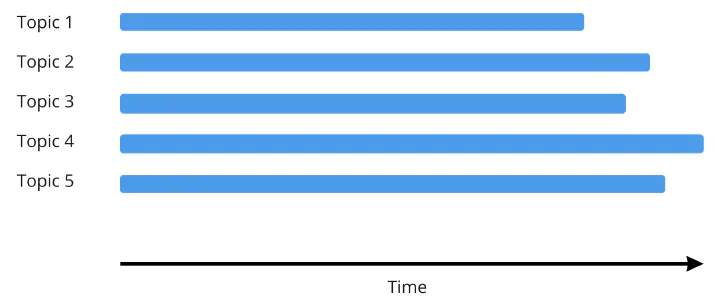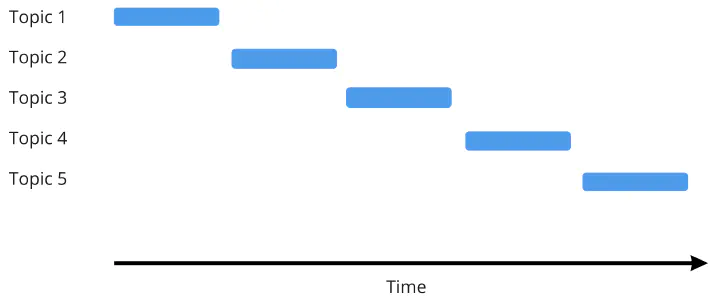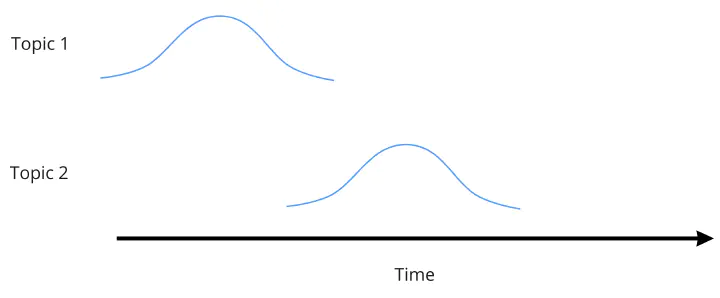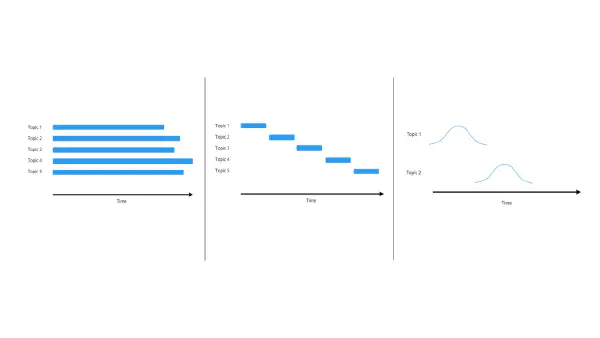Ineffective Busyness
If a team works on too many topics at the same time, employees will eventually specialize in individual topics. This has disastrous consequences for the team:
-
Knowledge silos: If one person drops out, the topic is at a complete standstill until he or she is back and can continue working.
-
Suboptimal solutions: If only one person is working on a topic, there is no discussion about different solutions, there is no pair programming and reviews become shallow. This increases the likelihood that simpler and better solution paths will be overlooked or design decisions will be made that lead to problems later.
-
No real team collaboration: The team essentially becomes a group of lone wolves, dailies, plannings and other team meetings lose much of their value and feel more and more like a waste of time.

Figure 1: Parallel processing of multiple topics in one team.
-
All topics are finished relatively late: This is certainly the biggest problem (from a management perspective). If many topics are worked on in parallel, only a fraction of the team capacity is available for each topic and everything takes correspondingly longer. (see Figure 1). As a result, individual topics can drag on for a very long time and never seem to be properly completed.
In this state, there is an ineffective busyness. Everyone is working at full capacity, but little to nothing is completed. This busyness only creates the illusion of progress.
In order to go fast, you have to go slow.
To get out of this situation, the team needs to complete things again. Here, focus is key for the team and can be established for example through a Work in Progress Limit (WiP Limit). This means there is only a very limited number of topics that are worked on in parallel in a team. So what is the impact of applying a WiP Limit of 1 in the situation above?

Figure 2: Focused work on a topic in a team.
Figure 2 illustrates the result. By having the entire capacity of the team available for one topic, the topic can be completed much more quickly. Everyone participates in the implementation, thus there is intensive exchange and the probability of finding a significantly better solution increases. In our example, the first topic can thus be completed after a relatively short time. This creates motivation among the team and trust among the stakeholders. In this way, a positive upward spiral can be set in motion.
Figure 3: Transition between two topics.
Of course, this is just theory for now. Not every topic can be worked on in parallel. There are topics that may need to be prepared by a small group (user interviews, prototyping, etc…). In other words, some parallelism may well exist in the team, as illustrated in Figure 3, as long as it is limited and does not exceed the capacity of the team. Personally, I’m a big fan of a hard WiP limit of 1 for large topics, with the exception of the change phase where a new topic can be ramped-up while the existing one slowly fades out.
“We can’t make that work for us”.
A few years ago, I was in exactly the situation described above. We worked on too many topics in parallel and nothing got done. Everyone (product management, developers, testers, UX, scrum masters) complained about it.
_“We have too many topics in the team. We need more focus. Management needs to change something. We can’t go on like this.”
Until someone said the crucial sentence:
“What’s stopping us from setting a focus and WiP limit ourselves? We all agree that we want it. It’s an intra-team thing, we can make it happen.”
So we did. At first, not all stakeholders were enthusiastic about our approach. We heard the phrase “But what about my issue?” a lot during that time. But after only a short time, we began to close topics that had accompanied us for months in some cases. In the time that followed, we systematically continued to close issues, one after the other. The complaints became fewer and the team developed very well during that time. However, the pressure from outside was great and there were always moments when the team gave in to the external pressure and then had to painfully come back to its senses.
Summary
Pointless busyness is the normal state if a team does not actively counteract, and it is tiring and frustrating for any team. A hard WiP limit can help to create focus and finally start to complete things again and thus generate real progress.


